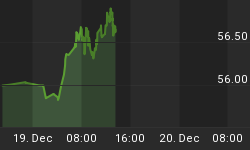The market has been bouncing around above its bear market low for the last five months. Question -- what kind of guideposts, if any, do we have regarding the big picture?
Do you remember the 50% Principle. The Principle is concerned with what the market does at the halfway level of a major advance or a major decline. The greater the advance or decline and the longer the duration, the more valid is the 50% Principle
From its January 2000 bull market high to its October 2002 low, the Dow has been declining for better than three years. From its bull market high to its bear market low, the Dow lost 4436 points. In duration and extent, the Dow has lost enough so that the 50% Principle can be applied with authority.
The bull market high for the Dow was 11722. The bear market low, so far, was recorded last October at 7286. The halfway level of the entire bear market decline comes in at 9504.
Here's what the 50% Principle is telling us. If the Dow can rally back decisively above 9504, then the 50% Principle says that in due time the Dow could advance to test its 11722 high again.
Conversely, if the Dow fails to rally above 9504, then the 50% Principle states than in due time the Dow will decline to test or violate its October 2000 low of 7286.
As I write the Dow is fluctuating within 550 points of its bear market low of 7286. But the Dow is also 1660 points below the halfway (9504) level of the bear market.
So will the Dow decline to test 7286 or will the Dow rally to close above 9504?
Answer -- As long as the Dow holds below 9504, the 50% Principle gives the odds to the bears. Barring a rally above 9504, the 50% Principle is saying that the Dow is fated to break to a new bear market low -- below 7286. There's no time limit.
Sentiment -- One of the items I use for identifying a bear market bottom is sentiment -- bullish or bearish. And to my mind, sentiment today is still far away from the kind of sentiment I'd expect at a bear market bottom.
Along these lines, two items in today's Wall Street Journal caught my eye. The first on the op-ed page is entitled, "The Superball Economy." The gist is that the writer has "seen it all before," and that just because Silicon Valley is in the dumps now, he's convinced that tech is on the verge of getting a lot better. "Slamdown on your Superballs and get ready," he warns, because good times are coming.
The second article in the Journal is about mighty Cisco, which is down 80% from its high. But "a strange thing has happened," runs this article, "a new group of investors with no illusions of stratospheric growth have bought the shares, buoying them at a time when other stocks are continuing to drop."
I'm sorry to report that these are not the kind of articles we'll be seeing when this bear market hits its final bottom. There'll be nothing about revival and nothing about Cisco being a good buy. Instead, there will be desperate articles, pieces about why the "economy is a disaster," and why "a system other than capitalism" may have to tried.
From another standpoint, I note that according to the National Association of Investors Corporation states that the peak of its membership (investment clubs) occurred in 1998 at 37,129 clubs. Last year the total had only dropped to 32,345 -- down only 13.5%. Before this bear market is over, I would expect the number of investment clubs to drop 90% or to around 4,000 or even less.
This jibes with my studies of margin levels on the NYSE. The peak for margins occurred in March 2000 at $278 billion. The latest total is $134 billion. By the time this bear market is over, I expect margin accounts on the NYSE to be down to around $30 billion or even less.















